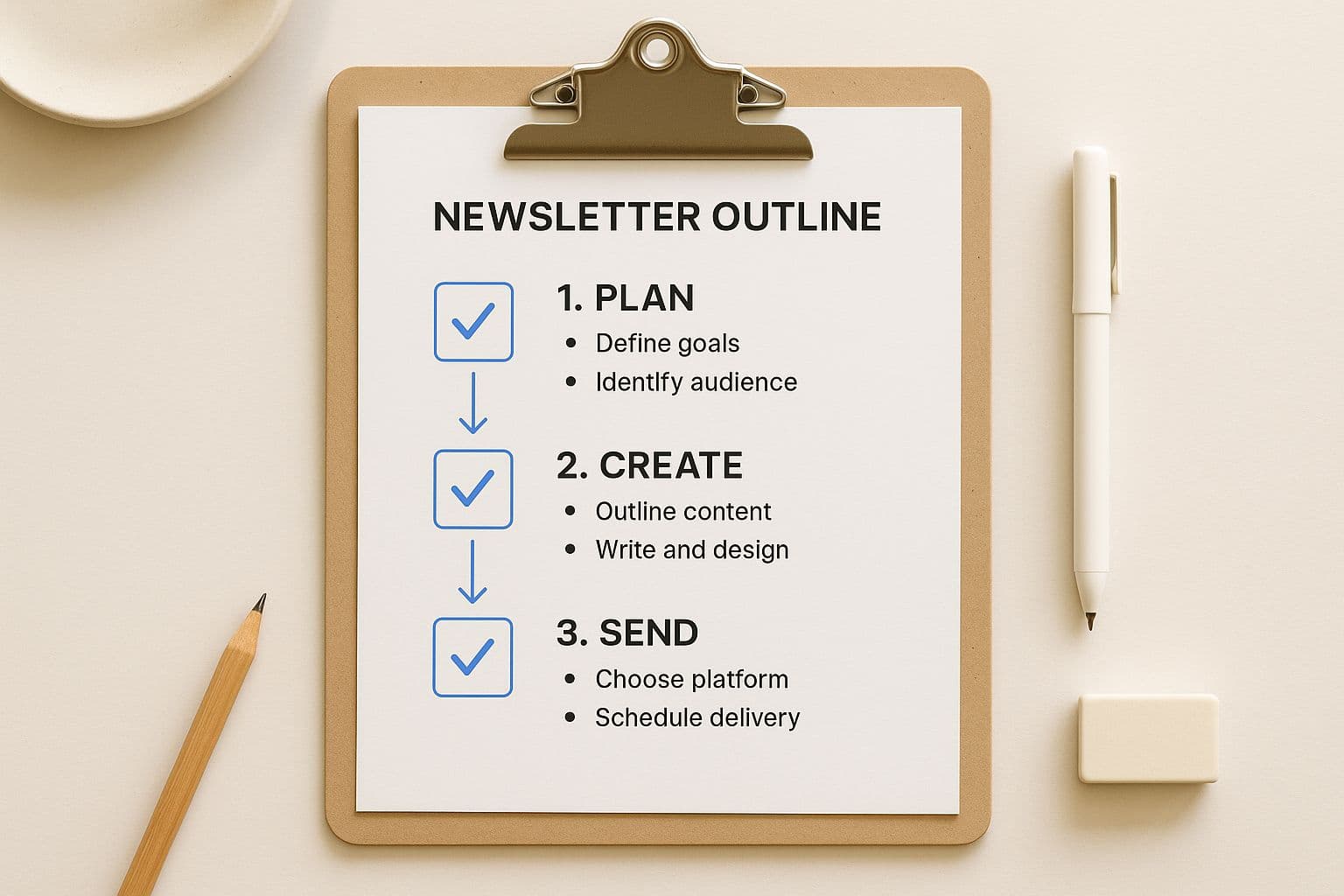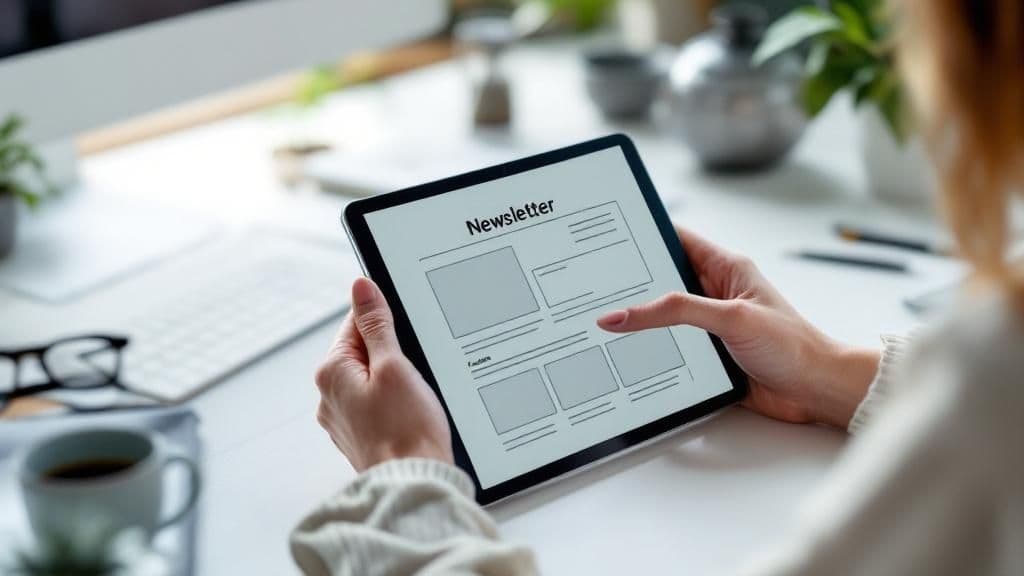How to Write a Good Newsletter People Actually Read
Learn how to write a good newsletter that captivates your audience. Get actionable tips on content, design, and growth to build a loyal subscriber base.

You've probably heard the classic advice: make your newsletter 90% educational and 10% promotional. It's solid advice, but I think it goes deeper than that. The real magic happens when you stop thinking about sending updates and start focusing on creating a direct, personal connection with your readers. You're giving them something valuable they genuinely can't get anywhere else.
Why Most Newsletters Fail and How Yours Will Succeed

Let's be real—everyone's inbox is a war zone. Most newsletters are DOA, deleted on sight. Why? Because they're boring, pushy, or just plain irrelevant. They feel like a marketing chore, a one-way street of company news and sales pitches that nobody asked for.
This isn't just another guide recycling the same old tips. It's about a fundamental shift in thinking that separates the newsletters people love from the ones they merely tolerate. The secret is to stop sending emails and start building a community. Your newsletter earns its keep by consistently delivering authentic value, issue after issue.
The Challenge of a Crowded Inbox
The fight for attention is brutal. By 2025, we're looking at over 376 billion emails flying around the globe every single day. That's a mind-boggling jump from just a few years ago. This explosion is happening everywhere; creator platforms like Beehiiv reported a staggering 700% increase in newsletters in just one year. If you want to dive into the numbers, these newsletter statistics paint a pretty clear picture.
In this kind of environment, being "good" isn't good enough. Your newsletter has to become essential.
The best newsletters feel like a personal note from a smart, trusted friend—not a memo from a faceless corporation. They offer a unique point of view, solve a nagging problem, or share an insight that makes the reader feel a little bit smarter.
Adopting a Community-First Mindset
Here's the trick: treat your newsletter like a product, not a promotion. Your subscribers are your customers, and you're asking for their most valuable asset—their attention. What are you giving them in return?
A winning strategy is built on a few core ideas:
- Building a direct line: Your newsletter is one of the last pure channels you own. No algorithm can get in the way of you talking directly to your audience.
- Earning genuine loyalty: When people see you consistently respect their time with high-value content, they don't just stay subscribed; they become your biggest fans.
- Becoming a welcome guest: This is the endgame. When someone sees your name pop up in their inbox and their first thought is, "Oh, awesome, I was looking forward to this," you've officially won.
Laying the Groundwork for a Newsletter That Clicks
Let's be honest, everyone gets excited about starting a newsletter. You have ideas, you want to share them, and you dive right into writing. But then... crickets. The reason most newsletters fizzle out is because they skip the most crucial part: the planning. A little bit of strategy upfront is what separates a newsletter people actually look forward to from one that gets instantly archived.
First things first, you need a crystal-clear goal. What is this newsletter really for? Is it your primary sales channel? A way to build a tight-knit community? Or maybe it's your platform for becoming the go-to expert in your space? Get specific here. "Grow my brand" is way too vague. "Increase new client consultations by 15% this quarter" – now that's a goal you can build on.
Having that single, sharp objective acts as your North Star for every piece of content you create.
Get Inside Your Readers' Heads
Once you know why you're writing, you have to figure out who you're writing for. And I mean really figure them out. Basic demographics are just the tip of the iceberg; they don't tell you what makes your audience tick or what problems they're desperate to solve.
Your mission is to uncover their biggest headaches, their secret ambitions, and the kind of content they'd genuinely miss if it stopped showing up.
- Become a fly on the wall: Lurk in the places your people hang out. Dive into relevant subreddits, join their favorite Facebook groups, or browse niche forums. Pay close attention to the questions that pop up over and over again. Those are pure gold.
- Spy on your competition (ethically!): Check out the comment sections on popular blogs and social media profiles in your field. This is where people drop unfiltered opinions, frustrations, and brilliant content ideas you can run with.
- Just ask!: If you already have a small audience or a few customers, don't be shy. A quick survey or a handful of 15-minute chats can give you more direction than weeks of guessing.
This is the kind of structured thinking that sets you up for success.

This whole process is about building your newsletter on a solid foundation of what your audience actually wants, not just what you feel like writing about.
Find Your Unique Flavor and Promise
Knowing your audience is one thing, but you also need to know what they're already reading. It's time to scope out the competition—not to copy them, but to find the gaps. What are they all doing well? And, more importantly, what are they completely missing? That gap is where your newsletter can shine.
This is where you'll craft your value proposition. It’s the simple, powerful promise that immediately answers every potential subscriber's biggest question: "What's in it for me?"
A strong value proposition isn't just a catchy tagline; it's a commitment. It sets the right expectations from day one and gives people a real reason to not just subscribe, but to actually pay attention.
To help you nail down these core elements, I've put together a simple canvas. Think of it as a cheat sheet for your newsletter's DNA. Just walk through the questions to bring your idea into focus.
Your Newsletter Content Planning Canvas
| Planning Element | Guiding Question | Example Answer |
|---|---|---|
| Primary Goal | What's the #1 thing I want this newsletter to achieve for me/my business? | To drive qualified traffic to my new blog posts and generate leads for my consulting service. |
| Target Audience | Who am I writing for? (Be specific!) | Freelance graphic designers in their first 1-3 years of business who are struggling to find high-paying clients. |
| Reader's Problem | What's the main pain point my newsletter will solve for them? | They don't know how to market themselves effectively or price their services with confidence. |
| My Unique Angle | How will my newsletter be different from others in this space? | I'll focus on actionable, no-fluff business tactics, not just design inspiration. I'll share real client stories and pricing breakdowns. |
| Value Proposition | What's my one-sentence promise to the reader? | "A weekly email with one actionable tip to help you land better clients and charge what you're worth." |
| "Voice" and Tone | What will my newsletter sound like? | Casual, encouraging, and a bit like a mentor. Like getting advice from a friend who's a few steps ahead. |
Filling this out takes the guesswork out of your content and ensures you have a clear, compelling reason to exist in someone's inbox.
Getting all this right takes effort. In fact, 62% of marketing pros say it takes them two weeks or more to develop a single email. That's why being efficient is key—we've even put together a guide on how to write faster and better to help you out. With the number of global email users expected to hit a staggering 4.89 billion by 2027, making your newsletter truly stand out isn't just a nice-to-have; it's everything. You can dig into more eye-opening email marketing statistics to see just how big the opportunity is.
Crafting Content That Earns Their Attention

Alright, this is where the magic really happens. A great newsletter lives or dies by its content. It's what makes people want to see your name pop up in their inbox, instead of hitting the archive button on sight.
The secret isn’t about pulling brand-new, earth-shattering ideas out of a hat every single week. That's a recipe for burnout. It’s about building a solid, repeatable structure that makes creating content feel manageable and, dare I say, fun.
A great way to do this is by setting up a few core content pillars. These are your go-to topics or formats your readers can count on. Think of it like your favorite podcast—you know the general vibe, but you're excited for each new episode's unique take. This gives you consistency and gives them a reason to keep coming back.
Finding Your Authentic Voice
One of the biggest breakthroughs you can have when learning how to write a good newsletter is finding a voice that sounds like an actual human being, not a corporate robot. People connect with people, simple as that. Your unique personality and perspective are your secret weapon.
Don't shy away from sharing a personal story, a behind-the-scenes look at a project, or even a time you messed something up. Being real builds a level of trust that polished, jargon-filled copy just can't touch. If you feel a bit stiff in your writing, brushing up on some professional email writing tips can help you find that perfect balance between casual and clear.
The best newsletters feel like getting an email from a smart, interesting friend. They’re personal, packed with value, and have a distinct point of view.
When you nail this, your newsletter stops being a marketing tool and starts feeling like a real conversation.
Core Content Formats That Actually Work
You don’t have to write a massive essay for every single send. In fact, you shouldn’t. Mixing up your content formats keeps things interesting and appeals to readers who might be short on time. For a deeper dive into creating a system that works, I highly recommend mastering your content creation workflow.
Here are a few of my favorite formats to keep in rotation:
- Curated Finds: Share the best articles, tools, or podcasts you've discovered. You become a trusted filter for your audience, saving them a ton of time and delivering instant value.
- Expert Interviews: Bring in another voice! An interview adds instant credibility and introduces your readers to new ideas, making your newsletter the go-to resource in your niche.
- Case Studies & Real-World Wins: Break down how a specific strategy or tool delivered real results. Nothing is more convincing than showing people what's possible and giving them a blueprint to follow.
Copywriting That Hooks and Holds
At the end of the day, it all comes down to the words you use. You could have the most brilliant idea in the world, but if it’s trapped in a dense wall of text, no one will read it. Your goal is to make your writing impossible to ignore.
Think about the difference here.
Before: The Corporate Wall of Text "Our latest feature release includes several key enhancements designed to optimize user workflow and improve productivity. We have integrated a new dashboard module that provides at-a-glance analytics, and the reporting function has been updated with more robust filtering capabilities to allow for more granular data analysis. Users will find these updates beneficial for their daily tasks."
After: Scannable and Human "Ready for a much better workflow? We just rolled out two updates you're going to love:
- A New "At-a-Glance" Dashboard: See your most important numbers the second you log in. No more digging.
- Smarter Report Filters: Finally, you can drill down to get the exact data you need.
These aren't just small tweaks—they’re designed to save you real time, every single day."
See what happened? Short sentences, a direct question, bullet points, and bold text make the information jump off the page. It’s all about respecting your reader's time and getting straight to the good stuff. Do that, and your message will always hit home.
Designing for an Effortless Reading Experience
Your writing can be brilliant, but if it’s trapped in a clumsy, cluttered design, it’s dead on arrival. When you're figuring out how to write a good newsletter, you have to remember that how your content looks is just as important as what it says. The good news? You don’t need to be a graphic designer. You just need to care about clarity.
The whole point is to make reading feel effortless. This means leaning into a clean, minimalist vibe that naturally guides your reader’s eye down the page. Think of white space not as empty, but as a powerful tool. It gives your words room to breathe and keeps your readers from feeling overwhelmed by a wall of text.
Start with a Mobile-First Foundation
Before you even think about fonts or colors, you need to bake in a mobile-first mindset. Seriously. Up to 73% of people prefer to read their newsletters on a mobile device. This isn't some fleeting trend; it’s the new normal. If your newsletter is a jumbled mess on a phone, you’ve already lost.
This means embracing a single-column layout. It’s the simplest, most foolproof way to make sure your content looks great everywhere, from a tiny phone screen to a giant desktop monitor. It also forces you to be disciplined, presenting your ideas in a clean, linear flow that anyone can follow.
Your newsletter isn't a webpage. It's a personal message that lands in an intimate space—the inbox. Design it with the simplicity and directness of a well-written letter, not a complex website.
Readability Is Everything
The actual text on the screen? Your choices here make a huge difference in whether people will actually read what you wrote. For maximum readability, keep these fundamentals in mind.
- Pick a Solid Font: Don't get fancy. Stick to standard, web-safe fonts like Arial, Helvetica, Georgia, or Verdana. They're built for screens and look consistent no matter what email app someone is using. For body text, aim for a font size of at least 16px so people aren't squinting.
- Use Visuals with a Purpose: Sure, images and GIFs can inject some personality and break up long blocks of text. But use them strategically. Every single visual should have a job—to illustrate a point, spark an emotion, or just give the reader’s eyes a quick break. If it's just there for decoration, it's probably clutter.
- Go for High Contrast: Make sure your text color stands out from the background. The classic black or dark gray text on a white background is the gold standard for a reason: it works. Poor contrast makes people strain their eyes and is a huge accessibility no-no.
Make Your Call to Action Unmissable
Your call-to-action (CTA) is probably the single most important design element in your entire newsletter. It absolutely has to pop. Don’t just hyperlink a sentence and hope for the best—use a button.
A great CTA button has a few things going for it:
- It’s a color that contrasts with everything else around it.
- It has plenty of white space so it doesn’t feel crowded.
- The text is short, clear, and tells people what to do (e.g., "Read the Full Post," "Shop the Sale").
When you combine a clean, mobile-first layout with smart typography and a can't-miss CTA, you're showing respect for your reader's time. This kind of thoughtful design gives your carefully crafted words the best possible chance to be read, understood, and acted on.
Getting Subscribers and Knowing What's Working
You can write the world's greatest newsletter, but it doesn't mean much if no one's reading it. Getting those first few subscribers can feel like a slow, uphill battle, but you're probably closer to your first milestone than you think.
Your first move? Tap into your existing network. I'm talking about friends, family, and colleagues who already know and trust you. But don't just blast them with a generic "subscribe now" email. Send a quick, personal note explaining what you're building and why you think they, specifically, would find it interesting.
From there, head to social media, but do it strategically. Nobody clicks on a desperate "Subscribe to my newsletter!" post. Instead, pull out a genuinely useful tip or a fascinating story from your latest issue. Give people a free taste of the value you offer, then invite them to get the full meal by subscribing. Your goal for that first month should be 100 subscribers. Hitting that number is a huge confidence boost and proves you're onto something.
How to Keep the Momentum Going
Once you've got some initial traction, it's time to build systems that bring in new readers while you sleep. You can't personally message everyone forever. A great starting point is implementing email sign-up forms everywhere you have an online presence—your website, blog, and social media profiles. Make it ridiculously easy for people to say "yes."
Beyond the basics, here are a couple of my favorite growth tactics:
- Build a referral program. Give your current subscribers a reason to tell their friends about you. Offer them something cool—an exclusive guide, a checklist, maybe a discount—for every new person they bring into the fold. This turns your biggest fans into your most effective marketing team.
- Run cross-promotions. Find another creator with a newsletter that serves a similar audience but isn't a direct competitor. You can agree to give each other a shout-out in an upcoming issue. It's a free, authentic way to get your work in front of an audience that's already primed to like it.
Look, the best growth engine you'll ever have is your content. When you create something so good that people can't help but talk about it, they'll do the marketing for you. Word-of-mouth is a slow burn, but it builds the most loyal and engaged audience you could ask for.
Measuring What Actually Matters
Drowning in analytics is easy. The trick is to ignore the noise and focus on the few metrics that actually tell you if you're headed in the right direction. Forget about obsessing over your total subscriber count—that's just a vanity metric. What you really want to track is engagement.
It's also worth remembering that newsletters are serious business now. In 2024, newsletter revenue models truly hit their stride. Just look at Beehiiv's Ad Network, which generated over $3.7 million** for its creators, while paid subscriptions pulled in nearly **$8.7 million. With the number of newsletters on the platform jumping by 96.2% in just a year, it's clear that smart strategy involves both great content and a path to monetization. You can dive deeper into these trends and discover insights from the 2024 State of Newsletters.
So, what numbers should you actually be watching?
- Open Rate: This is your first impression. It tells you if your subject lines are grabbing attention and if people are happy to see your name in their inbox. If this number starts to dip, your subject lines probably need a little more personality.
- Click-Through Rate (CTR): This is the real test. Are people actually engaging with your content enough to click the links inside? A high CTR is the ultimate signal that what you're writing is resonating.
- Unsubscribe Rate: Don't freak out every time someone leaves. A small, steady trickle of unsubscribes is perfectly healthy—it just means you're filtering for the right audience. A big spike after a specific issue, though? That's your cue to figure out what went wrong.
Think of this data as your feedback loop, not a report card. A low CTR on a link doesn't mean you're a failure; it just means that particular topic or call-to-action didn't land. Use these clues to make your next issue even better.
Got Questions? We've Got Answers
Even the best-laid plans hit a snag or two once you're in the trenches. It's totally normal. So, let's tackle some of the most common questions that pop up when it's time to actually get your newsletter written and sent.
How Often Should I Really Be Sending My Newsletter?
Look, there's no magic frequency that works for everyone. The most important thing? Consistency. Your subscribers want to know they can count on you.
Whether you decide on a weekly, bi-weekly, or monthly schedule, the real secret is choosing one you can actually maintain without burning yourself out. A fantastic monthly email will always beat a sloppy, rushed weekly one. Keep a close eye on your analytics—if open rates start to dip or your unsubscribes tick up, you might be overdoing it. On the flip side, if everyone's loving your stuff and you've got more great ideas than you can fit, you can always try sending it a little more often.
What Are the Best Tools for Someone Just Starting Out?
When you're new to the game, you want something that's easy to use and won't break the bank. Platforms like Beehiiv, Substack, and Mailchimp are my go-to recommendations.
- Beehiiv: This one is built for growth. If you're serious about turning your newsletter into something bigger, it has the tools to help you get there.
- Substack: If you just want to write and maybe charge for subscriptions down the line, Substack's clean, simple interface is hard to beat.
- Mailchimp: A great all-around choice with a pretty generous free plan. It’s perfect for just dipping your toes in the water without any commitment.
The "best" tool really boils down to what you're trying to achieve. If you're running a business and need some serious automation, something like ConvertKit might be a better fit. My advice? Always start with a free trial or plan to see if you actually enjoy using the platform.
A great subject line gets the door open, but great content is what makes someone want to stay in the room. You can't have long-term success without dedicating real effort to both.
I'm Stuck. How Do I Find Content Ideas?
Writer's block happens to all of us. The trick is to have a system ready for when it strikes. The simplest source of ideas? Your own audience. Just ask them! Every question you get is a potential newsletter topic just waiting to be written.
I personally keep an "idea file"—it's just a simple note on my phone where I dump interesting articles, stray thoughts, or questions people have asked me. You can also look at your own greatest hits. Got a popular blog post? Turn it into a three-part newsletter series. See what others in your space are talking about and think, "What's my unique take on this?" When you have systems like these, you can even explore using AI for brainstorming. For a deeper dive, you can learn more about giving AI effective instructions by reading our guide on how system, user, and assistant prompts work.
Ready to make your writing workflow faster and smarter? With TypeBoost, you can apply your favorite AI prompts to any text, in any app, with a single keyboard shortcut. Stop copy-pasting and start creating at the speed of thought. Discover how TypeBoost can transform your writing process today.